SATARA TOURISM☰
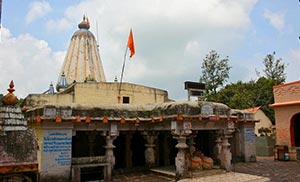
Amba Mohar Yatra, Yavateshwar
'Yawateshwar' is a small village on the foothills of the Yawateshwar hill, about
seven kilometres west of Satara city. The temple of 'Shri Shankara' was built
here during the Yadava period, and the temple of Bhairavnath, the village
deity next door, is the first Yatra of that deity in this area.
The pilgrimage to this temple is held every year on 'Ashwin Amavasya'.
Villagers from Yawateshwar, Sambarwadi, and Ambedare fulfil all the
responsibilities of this Yatra. A grand palanquin procession takes place to the
sound of drums. The palanquin is carried to the sacred mango tree near the
temple for worshipping the tree.
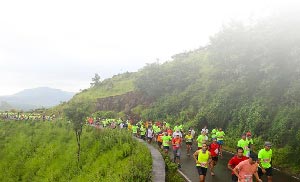
Satara Hill Marathon
'The Satara Hill Half Marathon' is usually held in the month of September,
attracting runners from all over India as well as elite athletes and runners from
around the world. This is the third-largest competition in the country and is
held on the difficult Yawateshwar Ghatmatha.
As many as 7,500 contestants from across the country participatein this
competition every year. The marathon is a challenge even for veterans who
have run some tough races the world over, which is why it is famous as the
Ultra Half Marathon.
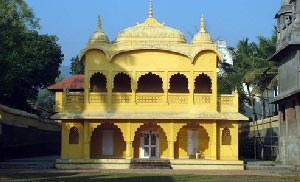
Dussehra Festival Jalmandir Rajwada Satara
In Satara, the 'Dussehra festival' is celebrated by worshipping the Bhavani
sword that was used by 'Chhatrapati Shivaji Maharaj'. A royal procession of
the sword begins at Chhatrapati Udayanaraje Bhosale's residence, the
Jalmandir Palace, and concludes at the Powai Naka area.
After the aarti, a palanquin procession of the Bhavani Talwar is taken out of
the Shri Bhavani Mata temple. 'This Bhavani sword' is placed in a traditional
wooden palanquin decorated with flowers and brought to Powai Naka in a
procession.
At the forefront of the procession are the Sanai-choughda, a group of horn
trumpets, royal courtiers, nauwari saree-clad girls, and feta-wearing youths. Firecrackers are set off after the procession reaches Povai Naka from
Rajpath.
Chatrapati Udayanaraja Bhosale perform the worship of this sword. After that
goddesses are immersed in artificial ponds.This procession leaves Rajpath in
Satara.
The ceremony of 'Simollanghana' has been taking place in Satara for many
years. Citizens attend in large numbers to witness this ceremony and catch a
glimpse of the royal sword.
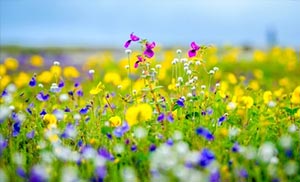
Kas festival
'The Kas festival' will begin in 2022 on the Kas plateau in the Satara district. The Tourism Department, District Administration, and Forest Department have organized this festival to promote tourism. During the festival, information about the characteristics and biodiversity of the villages in the Kas area is given. Various cultural programs are organized. This festival is held in 'Kas Plateau' from July to October.
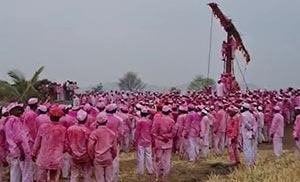
Bavdhan Bagad Yatra
Bavdhan village in Wai taluka is located at the base of fort Vairatgad, and the
Yatra to this village is considered to be the longest Yatra in Maharashtra.
More than 400,000 people participate in this Yatra, and one of the special
features is the hundreds of sturdy Khilar bullocks that are used to pull the
'Bagad' (Chariot of God). Bhairavnath Bagad Yatra is annually observed in the
'Rang Panchami' in Phalgun month. It is the most important and famous
annual festival at Bhairavnath Temple at Bavdhan near Wai in Maharashtra.
The festival is noted for devotees hanging from a hook from a high post. The
person who agrees to dangle from the hook performs a fast for 5 days. He
stays in a temple and on the 'Bagad' day eats only Neem leaves and does not
drink a single drop of water. 'The Bagad ritual' has a history of more than 800
years.
'Bhairavnath Bagad Yatra' is annually observed on 'Phalgun Krishna Paksha
Panchami' or the fifth day during the waning phase of moon in Phalgun month
as per traditional Hindu lunar calendar followed in Maharashtra.
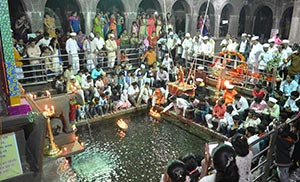
Krishnabai Utsav
The significance of the 'Krishnabai festival' is unique. The history behind the festival is that when Afzal Khan set out to vanquish Chhatrapati Shivaji Maharaj, Shendye Shastri of Wai invoked Krishnabai (Mother Krishna) for the victory of Shivaji. 'Krishnamai Festival' is annually observed in Magh month.
The annual utsav attracts hundreds of devotees to Wai in Maharashtra. 'Krishnamai Utsav' was started by Chhatrapati Shivaji Maharaj. It is dedicated to 'Krishna River'. Murti of Krishnamai is anointed during the occasion. The shrine is decorated with flowers, lamps and lights.
'Krishnamai Festival' is annually observed on Magh Shukla Paksha Pratipada tithi or the first day during the waxing phase of moon in Magh month as per traditional Hindu lunar calendar followed in Maharashtra.
The festival is celebrated not only on a religious level but also as a social tradition. This "Krishnabai Utsav" became the cultural glory of Wai.
The worship of Krishnabai, which first started at Ramdoh Aali, later started at all seven ghats. Bhimkund Galli, Madhali Galli, Dharmapuri, Ganapati Galli, In the order of Brahmashahi, Ramdoh Aali, and finally Gangapuri Galli.
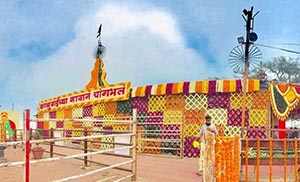
Mandhardevi Kalubai Yatra
The annual Yatra of 'Shri Kaleshwari' alias 'Kalubai' at Mandhardeo in Wai taluka in Satara district is held on the full moon of the Paush month, also known as Shakambhari Poornima or Chudi Poornima. 'Shri Kaleshwari Devi Adimaya' is a form of Parvati.
This temple is situated about 18 km from Wai, on a mountain.
On the full moon day in Paush month (January - February), a major festival takes place here and is attended by thousands of devotees. 'Kaleshwari Devi' is an incarnation of Goddess Shakti and is a hugely popular deity in this region of Maharashtra.
On the previous day of Purnima, there is a jagran during which a procession with the Kalubai Devi's idol sitting in a 'silver palkhi' goes through Mandradev village and culminates at the temple.
On 'Paush Purnima' more than 200,000 people gather at the temple. Devotees offer green colored saree to 'Kaleshwari Devi' on the day.
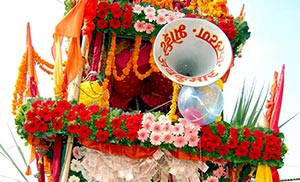
Rath Utsav, Shri Ram Yatra, Phaltan
In the presence of thousands of 'Shri Ram devotee's from various parts of the state, including Phaltan, the Rath Utsav is performed in a traditional manner.
The tradition of Rath Yatra, started by 'Sagunamata Aaisaheb' of the 'Naik Nimbalkar' royal family about 250 years ago, is still held every year.
On 'Margashirsha Shuddha Pratipada', i.e. on 'Dev Diwali day', the idol of 'Lord Shri Rama' is carried around the city in a beautiful decorated chariot. The chariot is duly worshipped by dignitaries. After that, the idols of 'Lord Shri Ram' and 'Mother Sita' are placed in the chariot and duly worshipped after which an aarti is performed.
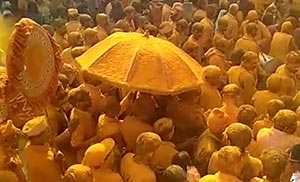
Khandoba Yatra, Kaalaj
Near Phaltan, in the Kalaj village, is a large temple of Khandoba. Within the sanctum sanctorum, sits a statue of Shankara.
According to tradition, after Khandoba married, there was a ceremony at Malwadi where turmeric was planted. Every month, all of these programmes are followed. Devachi Yatra, an annual yatra, is held in the month of February.
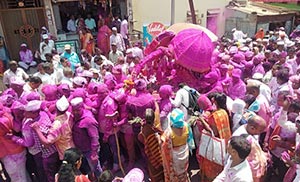
Mahanubhava Dakshina Kashi Ghoda Yatra
Mahanubhava Panth's horse journey, which is considered South Kashi, has been famous since ancient times.
Every year on 'Chaitra Vadya Pratipada', a horse fair is held at Phaltan, which lasts for five days. Chhabina leaves Shri Krishna Mandir every evening at 8 p.m. and reaches 'Shri Abasaheb Mandir' at 11 p.m. Aarti ends. (Chhabina means to dance in a round circle around the temple).
On the main day of the yatra, 'Shree Abasaheb' leaves Chhabina at one o'clock in the afternoon and comes to the temple at eight o'clock in the evening after circumambulating the city.
Devotees from all over India come to Phaltan for the Horse Yatra, including from Punjab, Haryana, Delhi, Himachal Pradesh, Rajasthan, Gujarat, Madhya Pradesh, Karnataka, and Telangana.
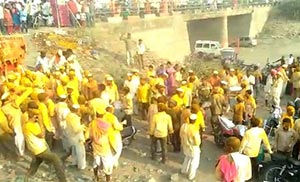
DhulDev Yatra
'Dhuldev Yatrra' is held in the month of Chaitra. There is a huge crowd. Following that, a large Dhuloba fair is held at Dhuldevwadi, about half a kilometer to the east of the Phaltan fair.
The traditional 'Gaji dance' of Dhangars is performed. It is a golden moment during the journey. Puran Poli a flatbread stuffed with jaggery is offered to the first Dhuldev.
Goats are slaughtered for the other Asuras (Khandyasuras). Such a fair is for Dhuldevs. Dhangari Ovya, Bhedik, and Bhakanuka are programs at the fair. This temple is known as Jagrut Devasthan and Dhuldev is the God who fulfils the wishes of the devotees.
Dhangar-shepherds from Karnataka and Andhra Pradesh also join in this yatra. Even today Dhuloba is the clan deity of the Vaghmode family in Dhangara. He is worshiped by building a tank or a temple, he is called the ancestor deity.
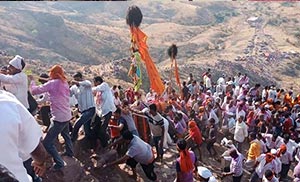
Shikhar Shingnapur (Kavad Yatra)
The journey to Shikhar Shingnapur takes twelve days. The Yatra starts from Gudi Padwa, i.e., Chaitra Shuddha Pratipada. The Yatra to Shree Kshetra Shikhar Shingnapur starts with the erection of an auspicious Gudi. On Panchami, turmeric is applied to Lord Shambhu and Goddess Parvati.
On Ashtami, Shiv-Parvati marriage is performed at twelve o'clock at night. The most amazing ceremony in the Yatra of Shri Shikhar Shingnapur is the Palkhi ceremony. Water from various pilgrimage sites is brought from Kavadi to anoint the deity.
'The Kawad Yatra' enters into shinganapur for worshipping lord shiva at the end of chaitra yatra. Devotees head to Mungi Ghat at Shikhar Shingnapur carrying heavy Kawad on their shoulders and chanted Har Har Mahadev.
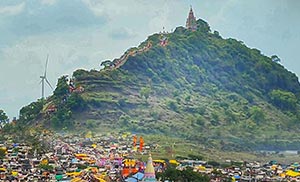
Takewadi (Satosha-Satoba Yatra)
Takewadi hosts the Yatra of Shree Satoba Dev, the deity worshipped by the entire Dhangar community. The Shree Satoba Devasthanam at Takewadi, north of Malwadi, is situated on a high hill, and the yatra fills the vast plateau below. Shri Satoba Deva's pilgrimage begins on Ghatasthapana.
On the first day, the image of God is drawn. On the next day, at 5 o'clock in the morning, the Maha Aarti is performed. A grand procession of the deity is taken out in a palanquin to the accompaniment of mana sticks, dhol-lezim, and the gaji band from various villages.
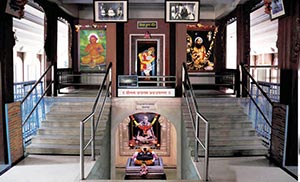
Gondawalekar Maharaj's death anniversary celebration
On the occasion of Shri Brahmachaitanya Gondawalekar Maharaj's death anniversary, a Lord Shri Ram is worshipped at Margashirsh Suddhapratipada. For this, Shri is first worshipped by the trustees. Shri's death anniversary is celebrated from Margashirsha Vadya Pratipada to Dasami.
Many devotees come to Gondavale to celebrate the death anniversary of Maharaj, stay for ten days, take Samadhi Sanni's name for their own salvation, and perform the service for the rest of the time.
During these ten days, Bhajans, discourse, Kirtans, and Classical singing are held in the temple from 6 a.m. to 11 p.m. It is a festival of joy for the devotees. Everyone believes that they are accomplish this true the blessing of Shri Maharaj.
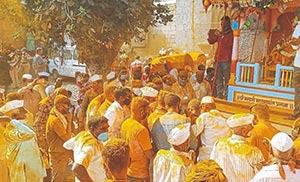
Malwadi Khandoba Yatra (Sat Yatra)
'Malavadi village' is located in Man taluka of Satara district along the 'Manganga River' at a distance of 12 km from Dahiwadi. In the olden days, there was a Dhangar settlement in this place; it was known as Mallewadi.
Khandoba Mhalsa's marriage ceremony is held in Margshirsha Shuddha Panchmeis, where thirty-six kulachars are performed.
'Margashirsha Ekadashi' is the main day of the festival here. On this day, in the afternoon, Rath Utsav and Palkhi are circling around the temple; at this time, some sticks (Manachi Kathi) come from local village for the festival.
In the middle of the night, 'Palkhi Sohla' departs from the temple and moves around the village. This Sohla reaches the temple at 6:20 AM. After that khandobas tiger (traditional idol) breaks the anchor (Langar), and the Yatra festival ends.
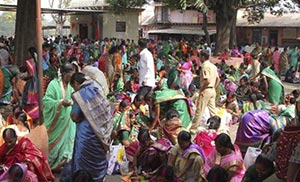
Sitamai Yatra
'Sitamarhi dongar' is the attractive place for the beautiful and peaceful nature. Sitamarhi dongarthe source of two rivers, is a very beautiful place.
Every year on the day of 'Makar Sankranti', 'Sitamai Hill' is filled with womens. Because on this day, Sitamai's annual yatra takes place. Thousands upon thousands of Suvasinis regard Sitamai as their soulmate. Legends about this area are also similar.
This is the place where Sitamai was left by Lord Lakshmana on the orders of Lord Sri Ramachandra. Also, Sitamai's later life was spent here. So, coming here, Suvasini becomes reconciled with the joys and sorrows of Sitamai. Here they eat food they brought with them. They play various games, have fun, and leave here very satisfied.
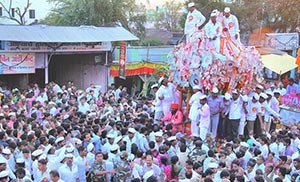
Sevagiri Maharaj Rathotsav, Pusegaon
'The rathotsav' of Sri 'Sevagiri Maharaj', Brahmalin Taponidhi Siddhahasta Yogi of Srikshetra Pusegaon (Tal. Khatav), is held in the month of January.
On the occasion of the death anniversary of His Holiness Shri Sevagiri Maharaj, an annual yatra is held in Pusegaon in a grand style.
During the 10-day period, various programmes are organized on the occasion of the pilgrimage to Sevagiri Maharaj, which is the place of worship for lakhs of devotees in West Maharashtra, Andhra Pradesh, Gujarat, and North Karnataka. Followers of Sevagiri Maharaj enthusiastically participate in this annual chariot pulling ritual.
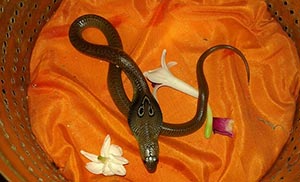
Nagnath Yatra Nagnathwadi (Shravan)
'Shri Nagnath Maharaj Yatra's, which are pilgrimages to the Swayambhu and Awakened Shining of Lord Mahadev at Nagnathwadi (Khatav), begin on the first Monday of the month of Shravan.
Shri Nagnath Maharaj's Shiva Mandir is known as Swayambhu and Jagrut Shivatirtha Devotion in Maharashtra, as is the entire Satara district.
The stone Shiva lingam in this Shiva temple is self-contained and 32 feet deep in water. Just as unbroken Ganga flows from the abode of Lord Shri Shankara, an unbroken spring of water flows from this holy Shivalinga.
Every day in the month of Shravan, this Shivlinga is opened by draining the water from the temple.
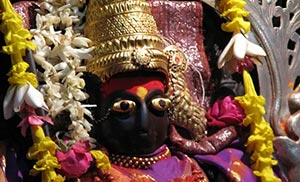
Yamai Devi Rathotsav, Aundh
The annual 'Paushi Rathotsav' of 'Sri Yamaidevi' at Aundh (now Khatav), a place of worship for lakhs of devotees in North Karnataka and throughout Maharashtra, is celebrated with great enthusiasm in the presence of devotees and villagers. At this time, "Ai Ude Ga Ambe Ude" is chanted.
Shri Yamaidevi's Rathotsav in Aundh has a century-long tradition. The Goddess's Utsav Murti is brought to the Sabha Mandap and is duly worshipped at this time.
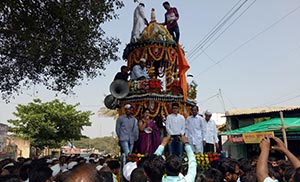
Yashwant Maharaj Siddheshwar Yatra
It is a place of Hindu-Muslim harmony. The big Yatra of 'Siddheshwar' takes place every year on 'Kartik Poornima', and villagers from far and wide as well as the devotees of Siddheshwar come from all over the district for darshan and to watch the Rathotsav ceremony.
Hindu and Muslim women in the village fast from 'Ashwin Purnima to Kartik Purnima'. This feature can be seen here. Also, Muslim brothers proudly say that Siddheshwar is their God, too. Baba's devotees from many places, including Malavar district, come for the darshan on manifest days, Gurupurnima, samadhi days, and every Thursday.
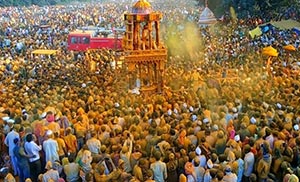
Pal Khandoba Yatra
Every year in the month of Paush, the marriage ceremony of Khanderaya and Mhalsa Devi takes place in a very enthusiastic atmosphere on Mrig Nakshatra. The setting of the Pali village of Satara looked very picturesque in the yellow colour of Bhandara. The ceremony of a deva's marriage is quite a sight to behold; initially, the idols of the deities are brought from the Khandoba and Mhalsa temples in Pali village, and the palanquin is carried by twelve Balutedars.This palanquin is charioted around the city before the marriage ceremony, which is performed on the Goraj Muhurta by blowing Bhandara and Akshata of coconuts while chanting the Vedas in the traditional manner.
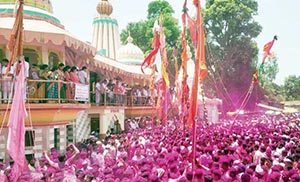
Yedoba Temple (Yeradgaon)
Yedoba temple is only 5 kilometres away from Patan. The temple is an attraction for devotees in a dense forest in a scenic area on the banks of the Koyna river. A pilgrimage takes place here on the full moon every month.
On the day of the main pilgrimage, a large crowd of devotees and tourists gather around 12 midnight to witness the pradakshina of the Yedoba temple. Devotees who come during the main period of the Yatra celebrate the Gaja Dhangari dance art form. Pilgrims flock to see this.
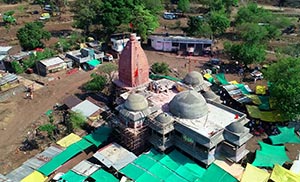
Naikba Banpuri Patan
The Naikba Yatra begins on Chaitra Padva and ends on Chaitra Shukla Panchami, Shashti. At the time of Gudhipadava, the honour sasankathi of the Shinde and Rainak families of Karad comes to Sri Naikba mountain. At the same time, the Bhoi Sasankatha from Kalgaon and Kole in the division arrive.
Around 40 to 50 sasankatha and palanquins from Kolhapur, Sangli, and Kurundwad divisions are involved in the early morning palanquin ceremony. In the presence of thousands of devotees, the image of Shri Naikba comes out with the Sasankatha amid the chanting of "Naikba Naam Changbhal." Devotees from Maharashtra and Karnataka gather in large numbers at this time.
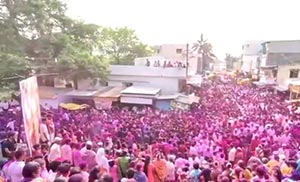
Koregaon Chafal Shri Ram Yatra
Prabhu Ram's Rathotsav at Chaphal, a pilgrimage site in Satara district, is celebrated on Ram Navami.
The festival is celebrated with great enthusiasm in the presence of thousands of devotees. Rathotsava starts at half past six in the morning. At this time, thousands of devotees from various parts of the district, including the Chaphal section, gather for the Rathotsava.
The Rath Yatra ends in the village with the chanting of Shri Ram's name and the beating of drums. This Rath Yatra ends near the Rathkhana near the temple.
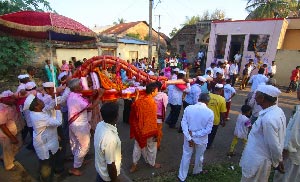
Dussehra Festival/Sharadiya Navratri Festival at Aundh
A year has three goddess festivals, one of which is Sharadiya Navratri. The deity of the Panth family, the representative family of the Sansthan (a very small kingdom before independence) was earlier Kardas; later, this goddess was brought to Aundh. First day: This is the day of Ashwin Shuddha Pratipada.
The idol of "Shri" is installed in a gold and silver makhara by performing religious rituals and performing "Punyah" vachan devak installation at the hands of Pantapratinidhi.
The religious ceremony of Mahanaivadha and Maha Arti Kortan begins after the establishment of the Nav Divas.
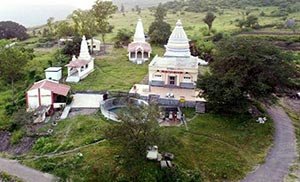
Chavaneshwar Yatra
An annual yatra is held here on the fourth weekend of Ashwin month. From the villages of Gulumb, Varakhwadi, Vaniniwadi, Karanjkhop, Randullabad, Sonke, Morbend, Hivre, etc., the Sasankathas of Mana come to this place.
Visiting these Sasankathyas is the main attraction of the yatra. Due to the greatness and natural beauty of this place, the number of devotees coming here is increasing day by day.
There is a turnover of lakhs of rupees here due to business. Also, the killing of animals is completely banned. Not only is there no bad custom or tradition, but there is also no pageant on the occasion of the yatra.